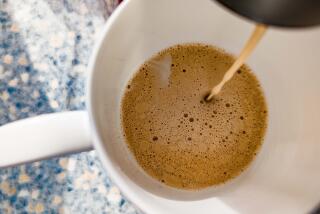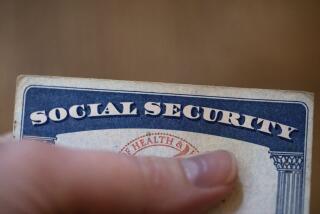Coffee Confusion Leaves a Bitter Taste
Question: This is a letter of protest. While coffee prices keep going up, the net weight keeps going down. Does the American consumer need this?
Some of us use a great deal of coffee. Practices such as above are a real hardship, particularly on a retirement income, such as we have. It’s been the case now for some time that the decaffeinated brands come in 13-ounce packages. I didn’t complain about that, mostly because of inertia. But I feel I must speak up now that all coffee seems to be packaged in 13-ounce cans. It’s an odd weight for a “pound” of coffee, to my tender sensitivities.
Chock Full o’ Nuts was the only 16-ounce brand I saw in the store today. It’s priced higher than the others, however. --C.L.
Answer: Join the crowd of confused consumers--we’re legion. And the first to admit the extent of the confusion is the coffee industry’s spokesman in New York City, George Boecklin, president of the National Coffee Assn.
“I can certainly understand the confusion, because the concept of what has happened is pretty technical,” Boecklin said.
What “has happened” is a new development in the coffee-roasting process that turns our traditional understanding of weight, volume and coffee brewing upside down. A situation in which “less” translates as “the same as.”
The new process, Boecklin explains, subjects the common green coffee bean to a “fast roast” at a higher temperature and with a different kind of ventilation. The result is a roasted bean that is somewhat larger than the conventionally roasted bean. So, what you’ve got is greater bulk. When it’s ground, the coffee that used to fit into a 16-ounce can now fits into a 13-ounce package.
“Obviously,” Boecklin continues, “you’re using less raw green coffee to produce the resulting ground coffee, but it makes the same number of cups of coffee as we’re used to getting out of a 16-ounce can.”
So, should you use less coffee to attain the same taste that you’re used to?
Not at all, according to Boecklin. “You use the same scoop measurement that you would with a 16-ounce can.” Normally there are about 40 scoops in such a can.
How’s this? You’ve got a package with 18% less raw material in it, but if you were accustomed to getting 40 scoops out of a 16-ounce can, you’re still going to get 40 scoops out a 13-ounce can?
As weird as this sounds, Boecklin insists, that’s what happens. You get the same number of scoops, and, therefore, the same number of cups of coffee.
The situation is analogous, he adds, to comparing the weight and the volume of a can of sand to a can of sawdust.
Additionally, Boecklin said, the larger roasted bean under the new process results, during the grinding process, in “a greater exposure of the surfaces of the coffee bean to the water and, therefore, a greater extraction of the flavor volatiles--the soluble solids, that is.”
In other words, just as the brewable amount of coffee remains unchanged in the process, so does the taste.
The new roasting process, and the trend to the 13-ounce package--which, in no way, is confined to decaffeinated brands--is pretty irreversible, Boecklin adds. Folger’s, the country’s second-largest coffee processor, has already announced that it is swinging 100% to the 13-ounce package, and Maxwell House, the largest, is expected to follow suit in short order.
The smaller producers, because the 13-ounce package is cheaper, “won’t have much choice in the matter.”
But you suggest that the 13-ounce package is showing up on your grocer’s shelves with a higher price tag. This, Boecklin says, “shouldn’t be. She should call it to the attention of the store manager. If she doesn’t get any satisfaction there, most of the major processors are including a toll-free 800 number on their cans, so she should tell them about it.”
A strange development, but one in which (appearances to the contrary) the consumer is buying a smaller can but getting the same amount of coffee as before.
Q: I am 61 years old and have been collecting Social Security since age 60 because of my status as a widow. When I am 62, I will, of course, be eligible for Social Security at a reduced rate, but it still will be a larger amount than if I were to use my husband’s benefits, as he died young and I have been working since I was 15.
May I continue to receive my husband’s benefits until I am 65 and then file for my own? Does the amount I have received from my husband’s account affect my own benefits in any way? Your column has provided me with much information in the past and, in fact, it was through reading it that I realized I would be entitled to widow’s benefits at 60, for which I thank you again.--V.M.D.
A: It was my pleasure.
Either scenario you choose--waiting until either 62 or age 65 to claim your own, rather than your dead husband’s benefit--is perfectly proper, according to Roy Aragon, Social Security’s public affairs spokesman here.
A few months before you turn 62, Aragon suggests, you should go to your nearest Social Security office and sit down with a representative to work out which option will be more beneficial for you. All offices have a chart that illustrates the “optimum point” at which you should file for benefits.
On the surface, it might seem logical to wait until age 65 (continuing to draw your husband’s benefits until then) and begin drawing your own full benefits at that time.
This isn’t always the case, however, Aragon adds. It’s frequently more beneficial to retire early and take your own reduced benefits at age 62 because--reduced, or not--you’re getting three full years of monthly payments before you would otherwise draw a cent. But there’s no real way of knowing without going over the actual figures with Social Security.
More to Read
Eat your way across L.A.
Get our weekly Tasting Notes newsletter for reviews, news and more.
You may occasionally receive promotional content from the Los Angeles Times.









